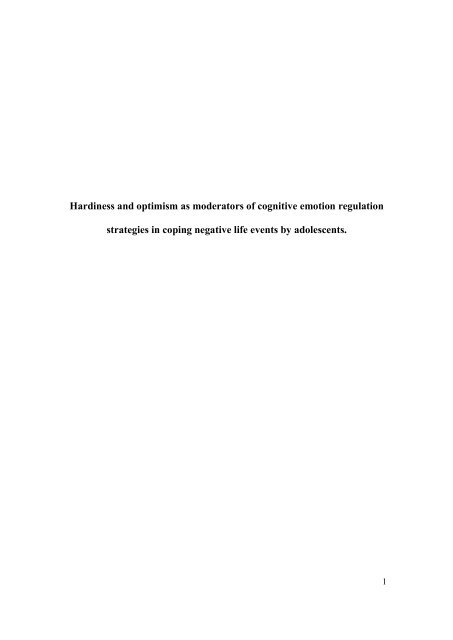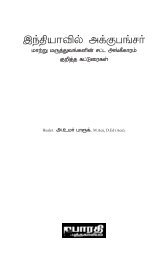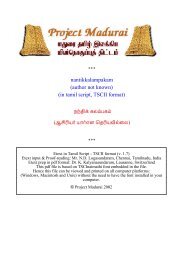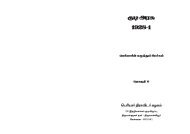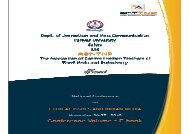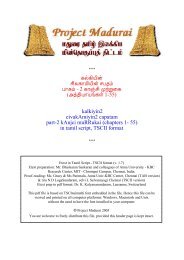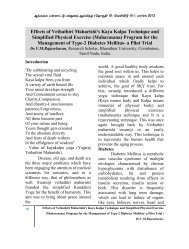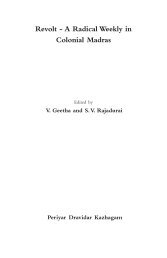Hardiness and optimism as moderators of cognitive emotion ...
Hardiness and optimism as moderators of cognitive emotion ...
Hardiness and optimism as moderators of cognitive emotion ...
- No tags were found...
You also want an ePaper? Increase the reach of your titles
YUMPU automatically turns print PDFs into web optimized ePapers that Google loves.
<strong>Hardiness</strong> <strong>and</strong> <strong>optimism</strong> <strong>as</strong> <strong>moderators</strong> <strong>of</strong> <strong>cognitive</strong> <strong>emotion</strong> regulationstrategies in coping negative life events by adolescents.1
<strong>Hardiness</strong> <strong>and</strong> <strong>optimism</strong> <strong>as</strong> <strong>moderators</strong> <strong>of</strong> <strong>cognitive</strong> <strong>emotion</strong> regulationstrategies in coping negative life events by adolescents.Pr<strong>of</strong>. Dr. S. Subramanian, Ph.D.,The Pr<strong>of</strong>essor <strong>and</strong> Head,Department <strong>of</strong> Psychology,Bharathiar University,Coimbatore 641 046,Tamil Nadu,IndiaE-mail: sugisubbu@hotmail.com / ssmsoma@yahoo.com.sgMobile: 99947 58447D.V. Nithyan<strong>and</strong>an, M.Phil., Ph.D.,Doctoral Research Fellow,Department <strong>of</strong> Psychology,Bharathiar UniversityCoimbatore 641 046,Tamil Nadu,IndiaE-mail: nithyan<strong>and</strong>an1981@gmail.com2
<strong>Hardiness</strong> <strong>and</strong> <strong>optimism</strong> <strong>as</strong> <strong>moderators</strong> <strong>of</strong> <strong>cognitive</strong> <strong>emotion</strong> regulationstrategies in coping negative life events by adolescents.ABSTRACTResearch on the promotion <strong>of</strong> resiliency <strong>and</strong> personal competency among those,who had encountered negative life events revealed that strength <strong>of</strong> individual’s internalresources tend to have a sizable impact on the adoption <strong>of</strong> different types <strong>of</strong> copingstrategies. Among the various internal resources, the two factors such <strong>as</strong> “<strong>Hardiness</strong>” <strong>and</strong>“Optimism” are identified <strong>as</strong> General Health promoting factors, which enable theindividuals to remain both psychologically <strong>and</strong> physically healthy despite encounteringnegative life events in adolescence stages.Data on <strong>Hardiness</strong>, Optimism <strong>and</strong> Pessimism Scale <strong>and</strong> the types <strong>of</strong> CognitiveEmotion Regulation Strategies from 160 adolescents, who had encountered negative lifeevents were collected. Results showed that those adolescents, who scored high on<strong>Hardiness</strong> <strong>and</strong> Optimism scales are more likely to engage in problem focused, active <strong>and</strong>support seeking coping strategies such <strong>as</strong> Positive Refocusing, Refocus on Planning,Positive Reappraisal <strong>and</strong> Putting into Right Perspectives with Positive Interpretation.Adolescents, who scored very low in <strong>Hardiness</strong> <strong>and</strong> Optimism scale are more likely toengage in distant, avoidant <strong>and</strong> <strong>emotion</strong>ally focused coping strategies such <strong>as</strong> self- blame,blaming others, ruminating, <strong>and</strong> cat<strong>as</strong>trophizing. The implications <strong>of</strong> results werediscussed with possible interventions to improve the internal resources among theadolescents, who had encountered negative life events.3
IntroductionSince the promotion <strong>of</strong> resiliency <strong>and</strong> competence h<strong>as</strong> become the focus <strong>of</strong>current health care efforts, concepts, which are relevant to underst<strong>and</strong>ing how anindividual’s psychological health might well be enhanced need to be addressed.Competency refers to the effectiveness <strong>of</strong> one’s actions in the world <strong>and</strong> a personal sense<strong>of</strong> well being in diverse are<strong>as</strong> <strong>of</strong> functioning (Baldwin et.al. 1993, Florian et.al 1995).Although the domain in which one can achieve competence vary widely (e.g.,behavioural, social, academic), the term implies that an individual h<strong>as</strong> demonstratedachievement in one or more are<strong>as</strong> <strong>and</strong> will continue to have the capacity to succeed infuture. Resiliency h<strong>as</strong> the capacity for successful adaptation despite challenging orthreatening circumstances <strong>and</strong> the development <strong>of</strong> competence <strong>and</strong> conditions <strong>of</strong> severeadversity (Funk, 1992, Kob<strong>as</strong>a et. al. 1982).Protective factors, which contribute to the development <strong>of</strong> resilience <strong>and</strong>competence (Weissberg, 1991, Williams et.al., 1992), incre<strong>as</strong>e the functioning <strong>of</strong> theindividual under conditions <strong>of</strong> significant adversity. Specifically, they serve to moderatethe impact <strong>of</strong> individual vulnerability or threatening environments.While given relatively little attention by intervention strategies <strong>and</strong> programs,results within the risk, resiliency <strong>and</strong> trauma literature have documented that anindividual’s internal resources <strong>and</strong> their contributions to resiliency is an additional <strong>and</strong>important area to pay attention. Two concepts, which have recently emerged within thearea <strong>of</strong> psychological resiliency <strong>and</strong>, which address the relevance <strong>of</strong> “internal4
characteristics” in helping one to overcome <strong>and</strong> deal with negative life experiences, are<strong>Hardiness</strong> <strong>and</strong> Optimism. Emerging from the medical literature, the concept <strong>of</strong> <strong>Hardiness</strong>w<strong>as</strong> first identified by Kob<strong>as</strong>a(1982) <strong>as</strong> a resistance factor in the early 1980’s.Preliminary findings revealed that individuals, who experienced high levels <strong>of</strong> stress, butremained healthy had a different personality structure than individuals who experiencedhigh levels <strong>of</strong> stress <strong>and</strong> became ill. The central domain <strong>of</strong> this personality structure,labeled <strong>as</strong> <strong>Hardiness</strong>, w<strong>as</strong> subsequently defined <strong>as</strong> “the use <strong>of</strong> ego resources necessary toappraise, interpret <strong>and</strong> respond to healthy stressors”. Although it continue to be employedmost frequently in the contexts <strong>of</strong> medicine <strong>and</strong> illness, researchers are beginning toconceptualize <strong>Hardiness</strong> <strong>as</strong> a General Health promoting factor, which enables theindividual to remain both psychologically <strong>and</strong> physically healthy despite confronted bystressful situations or experiences (Maddi <strong>and</strong> Kob<strong>as</strong>a 1984, Maddi et al., 2006).In contr<strong>as</strong>t to <strong>Hardiness</strong>, the concept <strong>of</strong> Optimism reflects an individual’sexpectation <strong>of</strong> a positive outcome in most situations (Scheier <strong>and</strong> Carver, 1985,Schneider <strong>and</strong> Leitenberg., 1989). It h<strong>as</strong> been argued that <strong>optimism</strong> enables the individualto set goals, make commitments, cope with adversity <strong>and</strong> pain <strong>and</strong> recover from trauma<strong>and</strong> stress. Numerous studies have examined the role an “Optimistic Bi<strong>as</strong>” plays inadolescent <strong>and</strong> adult mental health <strong>and</strong> reported a strong relationship between thepossession <strong>of</strong> an optimistic outlook <strong>and</strong> current self-reported happiness (Scheier <strong>and</strong>Carver, 1985, Schneider <strong>and</strong> Leitenberg., 1989).5
According to Kob<strong>as</strong>a (1982), the effects <strong>of</strong> hardiness on mental health aremediated by the individual’s <strong>cognitive</strong> appraisal <strong>of</strong> a stressful situation <strong>and</strong> his/herrepertoire <strong>of</strong> coping strategies. Specifically, hardiness alters two appraisal components –it reduces the appraisal <strong>of</strong> threat <strong>and</strong> incre<strong>as</strong>es one’s expectation that coping efforts willbe successful (Maddi et.al., 2006). <strong>Hardiness</strong> h<strong>as</strong> also been shown to be <strong>as</strong>sociated withthe individual’s use <strong>of</strong> active, problemfocused coping strategies for dealing withstressful events (Genrty <strong>and</strong> Kob<strong>as</strong>a, 1984, Kob<strong>as</strong>a, 1982). These two mechanisms are, inturn, hypothesized to reduce the amount <strong>of</strong> psychological distress one experiences <strong>and</strong> tocontribute to the long term psychological well being <strong>of</strong> an individual.Emotional regulation refers to all the strategies that are used to reduce, maintainor incre<strong>as</strong>e <strong>emotion</strong>s (Gross, 2001). Emotional regulation strategies are implicated inpersonality <strong>and</strong> <strong>emotion</strong>al, <strong>cognitive</strong>, <strong>and</strong> social development, including resiliency. Whenthey are bi<strong>as</strong>ed, they also play a prominent role in the development <strong>and</strong> maintenance <strong>of</strong><strong>emotion</strong>al disorders. In fact, the concept <strong>of</strong> <strong>emotion</strong>al regulation is very broad <strong>and</strong>encomp<strong>as</strong>ses a wide range <strong>of</strong> conscious <strong>and</strong> unconscious physiological, behavioral <strong>and</strong><strong>cognitive</strong> processes (Gross, 2001). Garnefski et. al. (2002) showed that people, whoadopt adaptive strategies report fewer depression <strong>and</strong> anxiety symptoms than people, whouse non-adaptive strategies. It is reported that less hardy individuals, who are more likelyto engage in distancing, avoidance <strong>and</strong> <strong>emotion</strong>ally focused coping strategies <strong>and</strong>individuals who score high on hardiness me<strong>as</strong>ures are more likely to engage in problemfocused,active <strong>and</strong> support seeking coping strategies (William et.al, 1992, Evans <strong>and</strong>Dunn, 1995).6
Objectives <strong>of</strong> the Study:The primary objectives <strong>of</strong> the research study are given <strong>as</strong> below:i) To explore the extent to which hardness <strong>and</strong> <strong>optimism</strong> moderate the types <strong>of</strong> <strong>cognitive</strong><strong>emotion</strong> regulation strategies among adolescents who had encountered negative lifeevents.ii) To find out the difference between the adaptive <strong>and</strong> non-adaptive <strong>cognitive</strong> <strong>emotion</strong>regulation strategies among adolescents who had encountered negative life events.Methodology:Sample:The sample for this study consists <strong>of</strong> 160 adolescent students who had failed inthe higher secondary school examinations (Tamil Nadu State Board Higher Secondary +2level Examination) <strong>and</strong> at present enrolled in tutorial colleges to continue their studies.Ages ranged from 17 to 19 years with a mean age <strong>of</strong> 18.3 (SD = 1.01). They had failed intheir higher secondary examination first time <strong>and</strong> had encountered negative life eventsmore significantly at their young age <strong>and</strong> had depressed state <strong>of</strong> feelings for quite sometime.The administration <strong>of</strong> CERQ, <strong>Hardiness</strong> <strong>and</strong> Optimism w<strong>as</strong> part <strong>of</strong> a largerevaluation process including other questionnaire <strong>and</strong> <strong>cognitive</strong> t<strong>as</strong>ks. All participantswere tested individually after given their consent in writing. The questionnaire w<strong>as</strong>completed anonymously <strong>and</strong> no compensation w<strong>as</strong> given for participation. A total <strong>of</strong> 160male adolescent boys responded to a set <strong>of</strong> questionnaires. Among them 20 responses7
were not usable due to incomplete information in some <strong>of</strong> the items. There fore only 140subjects were involved in this study.Me<strong>as</strong>ures:i) Cognitive Emotion Regulation Questionnaire (CERQ):The CERQ is a 36 item self reporting questionnaire with a 5 point Likert responseformat (1 almost never to 5 almost always) designed to evaluate the <strong>cognitive</strong> <strong>as</strong>pects <strong>of</strong><strong>emotion</strong> regulation. The questionnaire is introduced by the following sentences, whichare written at the top: “Every one gets confronted with negative or unple<strong>as</strong>ant events now<strong>and</strong> then <strong>and</strong> everyone responds to them in his/her own way. With the following question,you are <strong>as</strong>ked to indicate, what you generally think, when you experience negative orunple<strong>as</strong>ant events.This questionnaire consists <strong>of</strong> nine dimensions such <strong>as</strong>:a) Acceptance: (Having thoughts <strong>of</strong> acceptance <strong>and</strong> resignation with regard to what oneh<strong>as</strong> experienced. e.g. I think that I have to accept that this h<strong>as</strong> happened).b) Positive Refocusing: (Having positive, happy <strong>and</strong> ple<strong>as</strong>ant thoughts instead <strong>of</strong>thinking about threatening <strong>and</strong> stressful events. e.g. I think <strong>of</strong> nicer things that what Ihave experienced).c) Refocus on Planning: (Having thoughts about what to do <strong>and</strong> how to h<strong>and</strong>le theexperience one h<strong>as</strong> had. e.g. I think <strong>of</strong> what I can do best)d) Positive Reappraisal: (Having thoughts the goal <strong>of</strong> which is to give a positivemeaning to the negative events in terms <strong>of</strong> personal growth. e.g. I think I can learnsomething from the situation).8
e) Putting into perspective: (Having thoughts that realize the negative event comparedto other events; e.g. I think that it all could have been much worse).f) Self-blame: (Having thoughts that blame oneself or what one h<strong>as</strong> experienced. e.g. Ifeel that I am the one to blame for it).g) Rumination: (Having thoughts about the feelings <strong>and</strong> thoughts that are <strong>as</strong>sociatedwith negative events. e.g. I <strong>of</strong>ten think about how I feel about what I have experienced).i) Cat<strong>as</strong>trophizing: (Having thoughts that emph<strong>as</strong>ize the negativity <strong>of</strong> the experience.e.g. I continually think how horrible the situation h<strong>as</strong> been).j) Blaming others: (Having thoughts that blame others for what one h<strong>as</strong> experienced.e.g. I feel that others are to blame for it).These nine dimensions were cl<strong>as</strong>sified into two categories <strong>as</strong> adaptive strategies(Acceptance, Positive Focusing, Refocus on Planning, Positive Reappraisal <strong>and</strong> puttinginto Perspective) <strong>and</strong> non adoptive strategies (Self-Blame, Rumination, Cat<strong>as</strong>trophizing<strong>and</strong> Blaming Others).ii) <strong>Hardiness</strong>:Twenty item abridged <strong>Hardiness</strong> Scale developed by Kob<strong>as</strong>a,(1982) w<strong>as</strong> used tome<strong>as</strong>ure <strong>Hardiness</strong>. Total score on this sale is considered for the <strong>as</strong>sessment <strong>of</strong> <strong>Hardiness</strong>.The higher score on this scale indicates the higher the <strong>Hardiness</strong>.iii) Optimism:A 10 item scale developed by Scheier, Carver, <strong>and</strong> Bridges (1994) w<strong>as</strong> used tome<strong>as</strong>ure Optimism levels <strong>of</strong> the participants. This me<strong>as</strong>ures dispositional Optimism. Thescale consists <strong>of</strong> two filler items, four positively-worded items, <strong>and</strong> four reverse-codeditems. Respondents indicate their degree <strong>of</strong> agreement with statements such <strong>as</strong>, "In9
uncertain times, I usually expect the best," using a five-point response scale ranging from"strongly disagree" to "strongly agree". It h<strong>as</strong> been used extensively in studies <strong>of</strong> stress,both with college students <strong>and</strong> with people going through stressful events, such <strong>as</strong>medical populations facing or recovering from serious dise<strong>as</strong>es or treatments.Results <strong>and</strong> Discussion:Relationship between <strong>Hardiness</strong> <strong>and</strong> Emotion Regulation Strategies:Pearson’s Product Moment correlation between <strong>Hardiness</strong> <strong>and</strong> Cognitive EmotionRegulation Strategies, Optimism <strong>and</strong> Cognitive <strong>and</strong> Emotion Regulation subscales werecalculated <strong>and</strong> presented in Table 1.Insert Table I about hereThe results in Table-I show that the four adaptive strategies, i.e. PositiveRefocusing, Positive Reappraisal, Putting into Perspective <strong>and</strong> Adaptive strategies weresignificantly <strong>and</strong> positively correlated with <strong>Hardiness</strong> <strong>and</strong> Optimism. Four non-adaptivestrategies i.e. Self-Blame, Rumination, Cat<strong>as</strong>trophizing <strong>and</strong> Non-adaptive strategies weresignificantly <strong>and</strong> negatively correlated with <strong>Hardiness</strong> <strong>and</strong> Optimism. This shows that theinternal characteristics will have a significant impact on the types <strong>of</strong> adaptive <strong>and</strong> nonadaptive<strong>emotion</strong> regulation strategies, while coping with the adverse situations. Apsychological intervention among those depressed people targeting these <strong>emotion</strong>regulation strategies will enhance their mental health.10
High <strong>and</strong> Low levels <strong>of</strong> <strong>Hardiness</strong> <strong>and</strong> Optimism <strong>and</strong> Cognitive Emotion RegulationStrategies:<strong>Hardiness</strong> <strong>and</strong> Optimism scores were rank ordered from highest score to thelowest <strong>and</strong> accordingly those, who fell under the Q1 (top 25 per cent) were categorized <strong>as</strong>high group <strong>and</strong> those who fell under the Q4 (bottom 25 per cent) area were categorized <strong>as</strong>low group in <strong>Hardiness</strong> <strong>and</strong> Optimism . The significance <strong>of</strong> difference between high <strong>and</strong>low groups were found out by ‘t’ test <strong>and</strong> the results are presented in Table 2 <strong>and</strong> 3.Insert Table 2 about hereThe results obtained in table 2 show that the adolescents with low hardiness <strong>as</strong>compared to those with high hardiness have significantly adopted more <strong>of</strong> non-adoptivestrategies such <strong>as</strong> self-blame, rumination <strong>and</strong> catestophizing. Where<strong>as</strong> adolescents withhigh level <strong>of</strong> hardiness tend to follow the more adaptive <strong>emotion</strong> strategies such <strong>as</strong>positive refocusing, positive reappraisal <strong>and</strong> putting into perspective than thoseadolescents, who were low in hardiness.However, the high <strong>and</strong> low hardiness groups did not differ significantly onAcceptance, Refocus in Planning <strong>and</strong> Blaming others. The comparison <strong>of</strong> these twogroups <strong>of</strong> adolescents (High <strong>and</strong> Low levels <strong>of</strong> <strong>Hardiness</strong>) who had encountered thesimilar types <strong>of</strong> negative life events such <strong>as</strong> failure in higher secondary school11
examination (+2 level examination) revealed that the level <strong>of</strong> hardiness is likely tomoderate the <strong>cognitive</strong> process at significant level <strong>and</strong> affect the overall <strong>emotion</strong>alregulation strategies.Insert Table 3 about hereThe results in the table 3 show that Optimism <strong>as</strong> a moderator plays the same role<strong>as</strong> the <strong>Hardiness</strong>. This is meaningful in the sense the hardy individual lays emph<strong>as</strong>is onhis /her own resources to deal with the failure or negative incident <strong>and</strong> develops anoptimistic attitude. Or in other words <strong>Hardiness</strong> results I the development <strong>of</strong> anOptimistic Attitude.Hardy <strong>and</strong> optimistic adolescents use more <strong>of</strong> adaptive <strong>cognitive</strong> copingstrategies, when coping with negative incidents. The CERQ can be used for the diagnosis<strong>of</strong> individuals with the purpose <strong>of</strong> explaining the extent to which someone, when usingthe nine specific <strong>cognitive</strong> coping strategies varied from his or her st<strong>and</strong>ard group. It isexpected that the same cohort, which had encountered the same negative incident maylikely to exhibit more or less the similar type <strong>of</strong> <strong>cognitive</strong> coping strategies. But, it isrevealed that the level <strong>of</strong> hardiness <strong>and</strong> <strong>optimism</strong> tend to moderate the adoption <strong>of</strong> thetypes <strong>of</strong> coping strategies significantly. This information can be <strong>of</strong> much importance indetermining the purpose <strong>and</strong> content <strong>of</strong> the <strong>as</strong>sistance. For example, the internal resources<strong>of</strong> individual can be enhanced sizeably through some intervention, which will facilitate to12
overcome non-adaptive <strong>cognitive</strong> strategies <strong>and</strong> subsequently in facilitating the adoption<strong>of</strong> more adaptive coping strategies to deal with negative events.The proper analysis <strong>of</strong> the types <strong>of</strong> <strong>cognitive</strong> emotive regulation strategiesfollowed by adolescents in adverse situations will facilitate to take up appropriateremedial corrective me<strong>as</strong>ures to put them in the right track <strong>and</strong> to enhance theirpsychological well being. In this way, it can be established that the extent to which someone uses adaptive (functional) <strong>and</strong> non-adaptive (dysfunctional) <strong>cognitive</strong> emotive copingstrategies, while encountering negative incidents can be enhanced by the level <strong>of</strong><strong>Hardiness</strong> <strong>and</strong> Optimism. This information can be <strong>of</strong> much importance to determine thepurpose <strong>and</strong> content <strong>of</strong> the required <strong>as</strong>sistance. For example, the b<strong>as</strong>is <strong>of</strong> the treatmentcould be the ways in which one can overcome non-adaptive (dysfunctional) <strong>cognitive</strong>emotive strategies more effectively <strong>and</strong> be able to follow the adaptive (functional)strategies. Further, it is quite obvious that, whoever had encountered some adverseincidents are likely to adapt either adaptive (functional) or non-adaptive (dysfunctional)strategies to overcome such incidents. But the functional strategies facilitate to balancethe mental health <strong>and</strong> prevent people to get into more depressive or aggressive states.The findings <strong>of</strong> this study revealed that the internal resources such <strong>as</strong> <strong>Hardiness</strong><strong>and</strong> Optimism mediate the choice <strong>of</strong> <strong>emotion</strong> regulation strategies by altering theindividual’s <strong>cognitive</strong> appraisal process, such that individuals are able to reframe orreinterpret adverse experiences <strong>of</strong> failure in the examination. Consequently, it is expectedthat the level <strong>of</strong> psychological distress experienced by them may likely to be reduced.13
Further, hardy individuals have the ability to cope in a way that is adaptive, onceadversity is perceived or encountered. This showed that the hardy person prefer to rely onactive, transformational coping strategies, which act to <strong>cognitive</strong>ly transform a“potentially negative event” into a “growth producing experience”. Further, it is expectedthat individuals, who are engaging in problem focused coping, generally demonstratefewer indications <strong>of</strong> distress <strong>and</strong> maladjustment. It is quite evident that the hardiness <strong>and</strong><strong>optimism</strong> in adolescence lead to the development <strong>of</strong> a range <strong>of</strong> functional adaptive copingstrategies even when affected by adverse situations such <strong>as</strong> failure in examination.Implementing suitable interventions early in the developmental stage, particularlyat primary <strong>and</strong> secondary school level will help build adequate internal resources(<strong>Hardiness</strong> <strong>and</strong> Optimism) <strong>and</strong> in turn enrich these <strong>cognitive</strong> self-regulatory, academic<strong>and</strong> interpersonal capacities, which may help to promote the development <strong>of</strong> moreadaptive coping strategies.14
Table 1: Relations between Cognitive Emotion Regulation Strategies <strong>and</strong> <strong>Hardiness</strong> <strong>and</strong>Optimism.CERQ sub scales<strong>Hardiness</strong> OptimismAcceptance .18 .12Positive Refocusing .33** .28**Refocus on Planning .17 .14Positive Reappraisal .35** .38**Putting into Perspective .41** .39**Self-Blame -.52** -.41**Rumination -.46** -.39**Cat<strong>as</strong>trophizing -.56** -.48**Blaming others -.09 -.10Adaptive Strategies .36** .31**Non-adaptive Strategies -.48** -.42****p
Table 2: High <strong>and</strong> Low levels <strong>of</strong> <strong>Hardiness</strong> <strong>and</strong> Cognitive Emotion Regulation Strategies.CERSLevels <strong>of</strong> <strong>Hardiness</strong>High (N=35) Low (N=35)Mean (SD) Mean(SD)MeanDifference“t”valuesAcceptance 10.82(2.72) 10.48(2.06) 0.34 1.17Positive Refocusing 10.96(2.50) 9.54(2.31) 1.42 4.94**Refocus on Planning 12.21(2.28) 12.19(3.74) 0.03 2.42Positive Reappraisal 12.15(2.51) 10.98(2.3) 1.17 4.04**Puttinginto Perspective 10.96(2.51) 9.36(3.41) 1.6 4.46**Self-Blame 7.03(2.00) 8.79(3.16) 1.76 5.45**Rumination 7.51(2.72) 8.93(3.32) 1.42 4.59**Cat<strong>as</strong>trophizing 9.69(2.61) 11.65(2.78) 1.96 6.10**Blaming others 10.82(2.72) 10.48(2.06) 0.34 1.17**p
Table 3: High <strong>and</strong> Low levels <strong>of</strong> Optimism <strong>and</strong> Cognitive Emotion Regulation Strategies.Levels <strong>of</strong> OptimismCERSHigh (N=35)Mean(SD)Low (N=35)Mean(SD)MeanDifference‘t’valuesAcceptance 10.48(3.06) 10.35(1.94) 0.13 0.66Positive Refocusing 10.94(3.16) 9.86(2.65) 1.08 3.07**Refocus on Planning 11.89(2.45) 12.15(2.51) 0.26 0.89Positive Reappraisal 11.29(3.64) 9.69(2.61) 1.60 4.25**Putting into Perspective 10.96(2.51) 9.54(2.31) 1.42 4.94**Self-Blame 7.77(2.40) 8.79(3.16) 1.02 2.95**Rumination 7.51(2.72) 8.84(2.20) 1.33 4.59**Cat<strong>as</strong>trophizing 9.86(2.65) 10.94(3.16) 1.08 3.07**Blaming others 9.54(2.31) 9.36(3.41) 0.18 0.36**p
References:1. Baldwin, A.L., Baldwin, C.P., K<strong>as</strong>ser, TG., Zex M., Samer<strong>of</strong>f, A., & Seifer R (1993).Contextual risk <strong>and</strong> resiliency during the late adolescence. Development <strong>and</strong>Psychopathology, 5, 741-761.2. Evans D. M., & Dunn, N. J. (1995). Alcohol expectancies, coping responses <strong>and</strong> selfefficacyjudgments: a replication <strong>and</strong> extension <strong>of</strong> Cooper et al.’s 1988’s study ina college sample. Journal <strong>of</strong> Studies on Alcohol, 56, 186-193.3. Florian V., Mikulincer, M., & Yaubman, O. (1995) Does <strong>Hardiness</strong> contribute tomental health during a stressful real life situation? The roles <strong>of</strong> appraisal <strong>and</strong>coping. Journal <strong>of</strong> Personality <strong>and</strong> Social Psychology, 68, 687-695.4. Funk, S.C (1992). Commitment <strong>and</strong> coping in stress resistance among lawyers.Journal <strong>of</strong> Personality <strong>and</strong> Social Psychology, 42, 707 – 717.5. Garnefski. N., Legerstee J., Kraiij. V.V., Van Ken Kommer, T., & Teerds, J. (2002).Cognitive coping strategies <strong>and</strong> symptoms <strong>of</strong> depression <strong>and</strong> anxiety: Acomparison between adolescents <strong>and</strong> adults. Journal <strong>of</strong> Adolescence, 25, 603-611.6. Gentry, W. D., & Kob<strong>as</strong>a, S. C. (1984). Social <strong>and</strong> psychological resources mediatingstress-illness relationships in humans. In W. D. Gentry (Ed.), H<strong>and</strong>book <strong>of</strong>behavioural medicine, (87-116). New York: Guilford Press.7. Gross J. J., (2001). Emotion regulation in adulthood: Timing is everything. Currentdirections in Psychological Science, 10, 214-2198. Kob<strong>as</strong>a., S.C. (1982). Commitment <strong>and</strong> Coping in stress resistance among lawyers.Journal <strong>of</strong> Personality <strong>and</strong> Social Psychology, 42, 707-717.18
9. Maddi, S.R., & Kob<strong>as</strong>a S.C. (1984). The hardy executive: health <strong>and</strong> stressHomewood II: Dow Jones Irwin.10. Maddi. S.R., Harvey R.H. Khoshaba D.M., Lu, J.L, Persico, & M., Brow (2006) ThePersonality construct <strong>of</strong> hardiness III: Relationship with repression,innovativeness, authoritarianism <strong>and</strong> performance. Journal <strong>of</strong> Personality 74 (2),575-59811. Scheier, M.F & Carver, C.S (1985). Optimism, coping <strong>and</strong> health: Assessment <strong>and</strong>implications <strong>of</strong> generalized outcome expectances. Health Psychology, 4, 219-24712. Scheier, M. F., Carver, C. S., & Bridges, M. W. (1994). Distinguishing <strong>optimism</strong>from neuroticism (<strong>and</strong> trait anxiety, self-m<strong>as</strong>tery, <strong>and</strong> self-esteem): A reevaluation<strong>of</strong> the Life Orientation Test. Journal <strong>of</strong> Personality <strong>and</strong> Social Psychology, 67,1063-1078.13. Schneider, M.J & Leitenberg, H. (1989). A comparison <strong>of</strong> aggressive <strong>and</strong> withdrawnchildren’s self-esteen, <strong>optimism</strong> <strong>and</strong> pessimism, <strong>and</strong> causal attribution for success<strong>and</strong> failure. Journal <strong>of</strong> Abnormal Child Psychology, 17, 133-144.14. Weissberg, R.P, Caplan, M & Harwood R.L (1991) Promoting competent youngpeople in competence-enhancing environments: A systems b<strong>as</strong>ed perspective onprimary prevention. Journal <strong>of</strong> Consulting <strong>and</strong> Clinical Psychology, 59, 830-841.15. Williams P.G., Wiebe, D.J. & Smith T.W (1992) Coping process <strong>as</strong> mediators <strong>of</strong> therelationship between hardiness <strong>and</strong> health. Journal <strong>of</strong> Behavioral Medicine, 15,237-255.19


